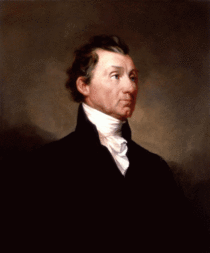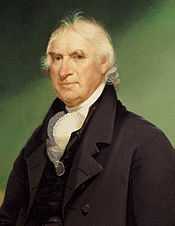United States presidential election, 1808
| | |||||||||||||||||||||||||||||||||||||||
| |||||||||||||||||||||||||||||||||||||||
| |||||||||||||||||||||||||||||||||||||||
|
| |||||||||||||||||||||||||||||||||||||||
| Presidential election results map. Green denotes states won by Madison, burnt orange denotes states won by Pinckney, yellow denotes states won by Clinton. Numbers indicate the number of electoral votes allotted to each state. | |||||||||||||||||||||||||||||||||||||||
| |||||||||||||||||||||||||||||||||||||||
The United States presidential election of 1808 was the 6th quadrennial presidential election, held from Friday, November 4, to Wednesday, December 7, 1808. The Democratic-Republican candidate James Madison defeated Federalist candidate Charles Cotesworth Pinckney decisively. Madison was serving as United States Secretary of State under incumbent Thomas Jefferson, and Pinckney had been the unsuccessful Federalist candidate in the election of 1804.
Sitting Vice President George Clinton, who was serving under Thomas Jefferson, was also a candidate for President, garnering six electoral votes from a wing of the Democratic-Republican Party that disapproved of James Madison.
This election was the first of only two instances in American history in which a new President would be selected but the incumbent Vice President would continue to serve. (The re-election of John C. Calhoun in 1828 was the other instance.)
Nominations
Democratic-Republican Party nomination
Presidential candidates
- James Madison (Virginia), Secretary of State
- James Monroe (Virginia), former Governor of Virginia
- George Clinton (New York), Vice President of the United States
Vice-Presidential candidates
- George Clinton (New York), Vice President of the United States
- Henry Dearborn (Maine), Secretary of War
- John Quincy Adams (Massachusetts), United States Senator
Balloting
Nominations for the 1808 presidential election were made by congressional caucuses. With Thomas Jefferson ready to retire, the Democratic-Republican caucus nominated Secretary of State James Madison of Virginia to succeed him. James Monroe was also a candidate for the nomination. In addition, Vice President George Clinton was a candidate for the nomination with support from New York Republicans, but was re-nominated by the caucus for a second term as Vice President.
| Presidential Ballot | Total | Vice Presidential Ballot | Total |
|---|---|---|---|
| James Madison | 83 | George Clinton | 79 |
| James Monroe | 3 | John Langdon | 5 |
| George Clinton | 3 | Henry Dearborn | 3 |
| John Quincy Adams | 1 |
Federalist Party nomination
The Federalist caucus renominated General Charles Cotesworth Pinckney of South Carolina and former Senator Rufus King of New York.
Presidential candidates
Vice-Presidential candidates
- Rufus King (New York), former U.S. Senator
General election
Campaign

The election was marked by opposition to Jefferson's Embargo Act of 1807, a halt to trade with Europe that disproportionately hurt New England merchants and was perceived as favoring France over Britain. Nonetheless, Jefferson was still very popular with Americans generally and Pinckney was soundly defeated, though not as badly as in 1804. Pinckney received few electoral votes outside of New England.
Results
Pinckney retained the electoral votes of the two states that he carried in 1804 (Connecticut and Delaware), and he also picked up New Hampshire, Massachusetts, Rhode Island, and three electoral districts in North Carolina besides the two electoral districts in Maryland that he carried earlier. Except for the North Carolina districts, all of the improvement was in New England.
The faithless electors who voted for George Clinton for President were all from New York.
| Presidential candidate | Party | Home state | Popular vote(a), (b) | Electoral vote(c) |
Running mate | |||
|---|---|---|---|---|---|---|---|---|
| Count | Pct | Vice-presidential candidate | Home state | Elect. vote(c) | ||||
| James Madison | Democratic-Republican | Virginia | 124,732 | 64.7% | 122 | George Clinton | New York | 113 |
| John Langdon | New Hampshire | 9 | ||||||
| Charles Cotesworth Pinckney | Federalist | South Carolina | 62,431 | 32.4% | 47 | Rufus King | New York | 47 |
| George Clinton | Democratic-Republican | New York | — | — | 6 | James Madison | Virginia | 3 |
| James Monroe | Virginia | 3 | ||||||
| James Monroe | Democratic-Republican | Virginia | 4,848 | 2.5% | 0 | (none) | (n/a) | 0 |
| (unpledged electors) | (none) | (n/a) | 680 | 0.4% | 0 | (n/a) | (n/a) | 0 |
| Total | 192,691 | 100% | 175 | 175 | ||||
| Needed to win | 88 | 88 | ||||||
Source (Popular Vote): U.S. President National Vote. Our Campaigns. (February 10, 2006).
Source (Electoral Vote): Electoral College Box Scores 1789–1996. Official website of the National Archives. (July 30, 2005).
(a) Only 10 of the 17 states chose electors by popular vote.
(b) Those states that did choose electors by popular vote had widely varying restrictions on suffrage via property requirements.
(c) One Elector from Kentucky did not vote.
Electoral college selection
| Method of choosing Electors | State(s) |
|---|---|
| Each Elector appointed by state legislature | Connecticut Delaware Georgia Massachusetts New York South Carolina Vermont |
| Each Elector chosen by voters statewide | New Hampshire New Jersey Ohio Pennsylvania Rhode Island Virginia |
| State is divided into electoral districts, with one Elector chosen per district by the voters of that district | Kentucky Maryland North Carolina Tennessee |
See also
- History of the United States (1789–1849)
- United States House of Representatives elections, 1808
- First inauguration of James Madison
References
- Presidential Election of 1808: A Resource Guide from the Library of Congress
- "A Historical Analysis of the Electoral College". The Green Papers. Retrieved March 20, 2005.
- A New Nation Votes: American Election Returns, 1787-1825
Further reading
- Brant, Irving, "Election of 1808" in Arthur Meier Schlesinger and Fred L. Israel, eds. History of American presidential elections, 1789-1968: Volume 1 (1971) pp 185-249
- Carson, David A. "Quiddism and the Reluctant Candidacy of James Monroe in the Election of 1808," Mid-America 1988 70(2): 79–89
External links
Navigation
| ||||||||||||||







